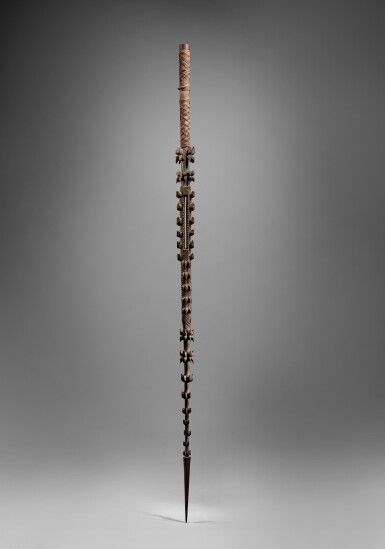The Scholar's Feast: The Rosman Rubel Collection
The Scholar's Feast: The Rosman Rubel Collection

Head of a Multi-Barbed Spear, Fiji
Lot Closed
April 8, 04:02 PM GMT
Estimate
2,500 - 3,500 USD
Lot Details
Description
Head of a Multi-Barbed Spear
Fiji
moto
Length: 56 ¾ in (144.1 cm)
Galerie Lemaire, Amsterdam
Abraham Rosman and Paula Rubel, New York, acquired from the above in 1983
Abraham Rosman and Paula Rubel, New York, acquired from the above in 1983
The unadorned shaft of this spear, or moto, has been cut, leaving one’s attention focussed on the elaborately carved head, which is both elegant and menacing. The two forms of sharp barbs on this spear are similar in appearance but may each possess an individual significance. The barbs that point both forwards and backwards – rendering it harder to pull the spear out after being struck – resemble those of a type of spear known as moto se ni nui, or “coconut flower”. Both these barbs and the pierced openwork section of the shaft resemble the example illustrated by Fergus Clunie in his classic Fijian Weapons and Warfare; he notes that it is “a rare form” (Clunie, Fijian Weapons and Warfare, Suva, 1977, n.p., fig. 29 g, and p. 70). The barbs which point in one direction only appear to be of kaka form, a name which derives from the resemblance between the barbs and the beak of the kaka parrot (Prosopeia tabuensis and Prosopeia personata). Clunie refers to the moto kaka type as a “priest’s or chief’s spear”. (Clunie, Yalo i Viti: a Fiji Museum Catalogue, Suva, 1986, p. 179).
